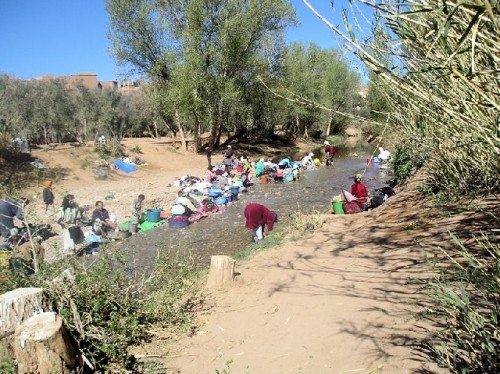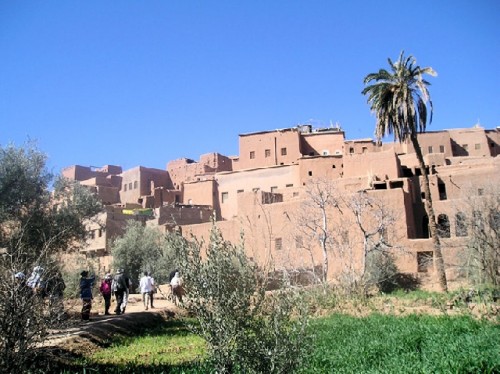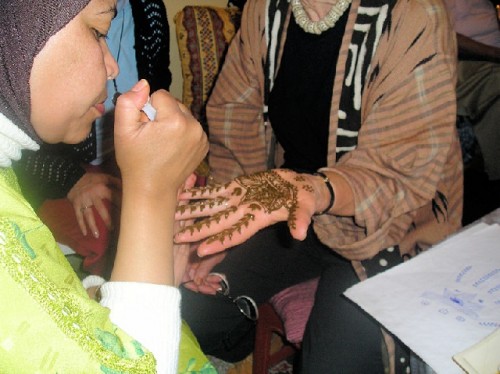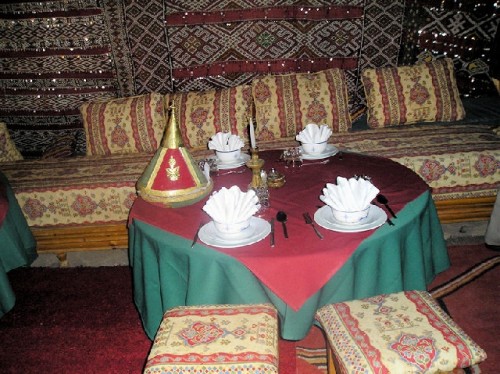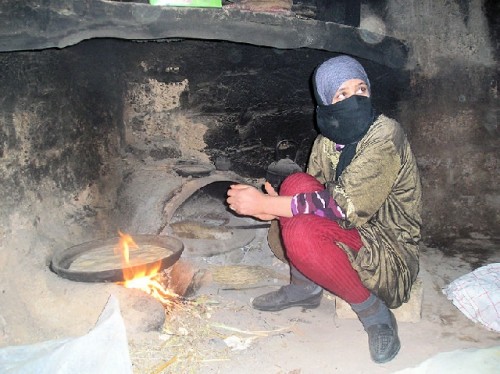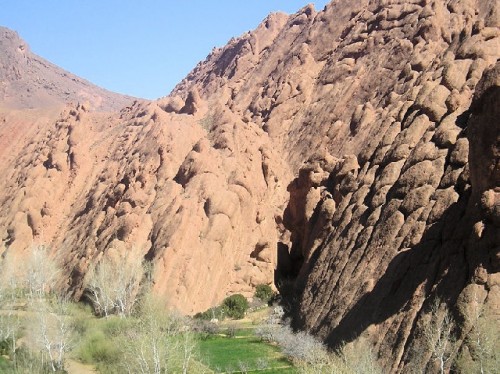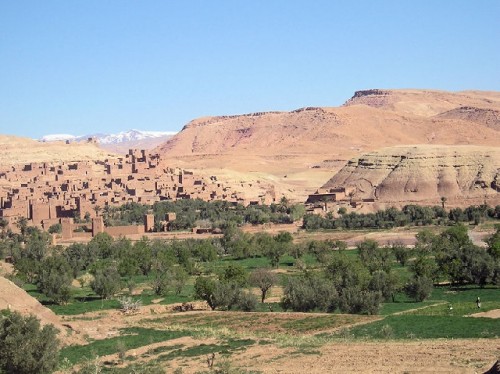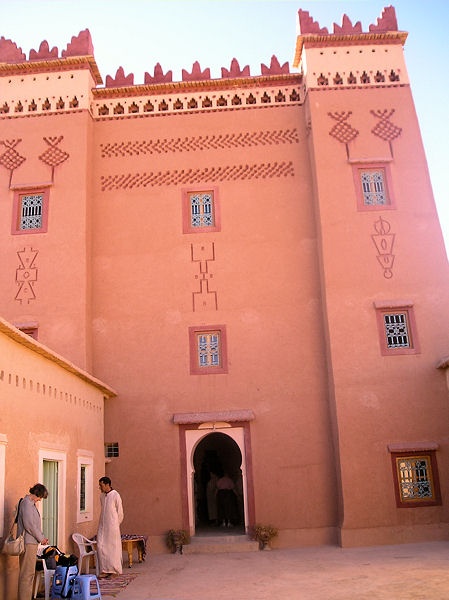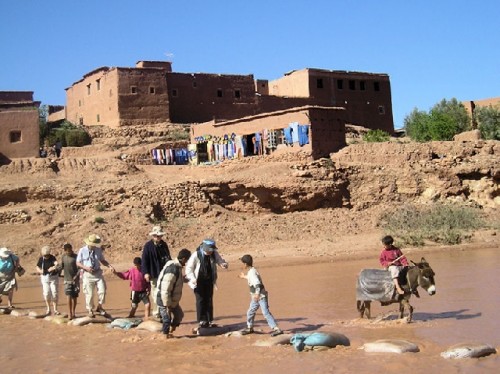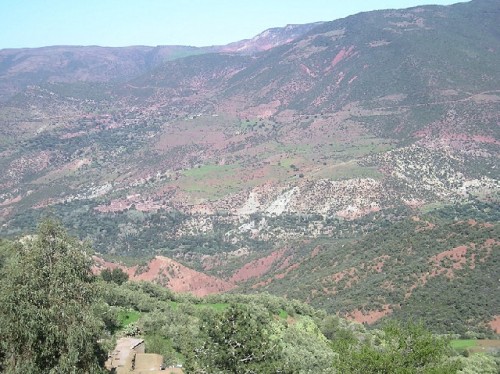Morocco: Part Five
Tineghir to Marrakech
By: Zeren Earls - Dec 23, 2007
Tineghir
By bus we drove to the oasis town of Tineghir crossing, at 4000 feet the Anti Atlas Mountains, which face the High Atlas. The terrain turned into mossy slopes with goats; rocks became boulders. Set against the crest of the mountain, Tineghir matches the pinkish glow of its surroundings. Buildings have flat roofs, with turquoise- or blue- framed doors and windows. When adobe houses deteriorate new ones go up. Settling here overnight, we washed off our desert dust and welcomed the altitude- tempered warmth.
Cafes surround the Tineghir town center. Mostly men of all ages sit here to watch the world go by. We joined them over a cola. Cigarette and candy stands under umbrellas, street vendors and shoeshine boys vied for our attention. An Internet cafe was full. We walked through the market where locals shop for household goods. I bought a green-and-red striped cloth finished with little pompoms at either end, which women wrap about their waste as an apron. We also strolled through the red light district, where many young girls that don't observe traditions at home end up as prostitutes. Rejected by their families and with no other place to go, they sadly sit in windows waiting for customers.
Dar ET-Taleb is a government-subsidized boarding house for poor children. 120 boys from the countryside aged twelve to twenty, live here while attending public school, until they pass the baccalaureate to enter university. Said, one of eight siblings took us on a tour of the premises. In addition to his native Imazighen, he spoke Arabic, French and English. He hoped to become an engineer. He showed us the dormitory, including the locker next to his bed, study hall, computer class, library and dining room. The menu, made up by the institution's doctor and cooked by women, was chickpeas with tripe, bread and oranges. Accustomed to tripe dishes in Turkey, I recognized the kitchen smells, which were unfamiliar to the rest of our group. We enjoyed mingling with the students; some asked us for Arabic-English dictionaries. They were allowed to watch TV on weekends and liked going to important soccer games. They had never seen the ocean.
On the way to Todra Gorge we passed by women doing their wash in the river and spreading it over shrubs to dry. Lunch was at the base of the gorge, with craggy rock walls looming1000 feet over a lush narrow valley of date palms and grain fields. A great treat was the visit to the Berber Artisan House. Our Tuareg host in blue garb welcomed us over freshly brewed mint tea while we watched him prepare. Assembled on trays were Chinese green tea, chunks of beet sugar, fresh mint, two teapots and clear glasses. After washing the tea in a pot of boiling water, he placed all the ingredients, including the sugar, in the other pot over a brazier. Then he bellowed the coals to simmer the tea. A Berber bellow, decorated with mirrors, is used by women in the kitchen when men are not around and covered up in their presence. Sugar is added to mint tea while it is prepared, making it quite sweet. Receiving tea without sugar means one isn't welcome.
Serving tea is a ceremony. The pot is held high up while the tea is poured with great virtuosity, filling the clear glass up to its gold-glazed band. As we enjoyed our tea, we had an introduction to Berber crafts and carpets, all of which are made using natural dyes: henna for red, saffron for yellow, mint for green, kohl for black, etc. We admired a sack made of dromedary leather, tent stakes carved from cedar, swords, and amber, coral and silver jewelry. Berbers do not wear gold because of its elitist associations.
Breath-takingly beautiful rugs and carpets filled with unique symbols of the village or douar, keys, doors, eyes, etc. unrolled before us. The color indigo represents the sky. Unlike most other rugs, which are either knotted or woven, Tuareg ones combine the techniques of knotting, weaving and embroidery. They are fringed only at one end. Although I have beautiful Turkish kilims, I could not resist buying a small Berber carpet, in addition to a necklace made of camel bone.
At a local home visit we had a demonstration of the regional henna custom for adorning women, especially new brides. The henna plant is native to North Africa. Crushed and powdered dry leaves mixed with water make a thick paint, which is applied to the hand with a syringe to draw designs. After the painted palm is dried over a brazier, the henna is fixed by sponging onto it a mixture of crushed garlic, lemon juice, sugar and pepper. Scraped the next day, the palm reveals a deep orange design. Six of us picked a traditional pattern from among several and had our hands adorned. Mine had a big eye in the center to ward off evil; it lasted about two weeks and wore off. In keeping with our distinctively Moroccan accessory, we had dinner at our hotel under a nomadic tent, which was totally covered with carpets from ceiling to floor, with mirrored ones on the walls.
Overland to Quarzazate
On our way to our next overnight stop, Quarzazate, we drove to Dades Gorge, shaped by the river that irrigates the Dades Valley. Admiring emerald green fields and fig trees we climbed to 7350 feet passing breath-taking peaks, valleys and giant sandstones, which locals call "the brains of the Atlas". Blended into the mountainside, red clay mud houses with windows small enough to let the light in distinguished themselves by their colored doors. Young girls with head covers carried big bundles of firewood and animal feed on their backs. The slogan "Western Sahara is ours" stood out against the mountainside. We stopped at a Sunday market crowded with goats and sheep sold for breeding. Bargaining was brisk and animated. Since Friday is a holy day, Sunday is a big market day.
Next we visited a Berber family for tea and homemade bread. The eldest daughter, confined to hard work, sat in a smoked filled kitchen, only her eyes visible through the head covers. After a three-year marriage her husband had divorced her because she could not conceive, thus dishonoring her family. We watched her chop the vegetables, place them in between two pieces of rolled-out dough, and bake it in a flat pan over an open wood fire. While waiting for the pizza we visited with her mother over tea, walnuts, almonds and fresh bread dipped in olive oil and honey from mountain flowers. All was delicious, including the pizza.
In Boulmane we called on the imam at his kasbah. The imam, who preached in Arabic, did not speak English, but nevertheless generously hosted us for lunch. After washing our hands from a kettle of warm water poured over a brass bowl, he served us lentil soup cooked in mutton broth. We sipped our soup directly from the bowls, which he filled from a large tureen. There were no utensils at the table. The main dish was gasaa: couscous steamed separately, then added to a pot of chicken with vegetables, cabbage, carrots, squash and turnips. He showed us how to eat by rolling the couscous into a ball with our right hands and popping it into our mouths. Dessert was bananas and tangerines; we left the peeled skins on the oilcloth, which he gathered to shake out in the kitchen. Mint tea completed our lunch.
Marriage is requisite to be an imam. His wife joined us after lunch to help dress a bride, who volunteered with her husband to go through a mock ceremony for our understanding of a traditional marriage, which is formalized by signing a contract drawn up by the imam. In Morocco a couple cannot get a hotel room without proof of marriage.
It is the mother's responsibility to find a wife for her son. Since boys stay with the family, the mother looks for a hard-working, reputable, pretty girl whom she would like to have around the house. The father goes with a slaughtered sheep to ask for the girl and to discuss a dowry(camel, goat, sheep) that his son must provide. Once an agreement is reached, a date is fixed for the wedding, which takes three months to prepare.
A wedding is a big weeklong communal event. The first day is for important people, the second only for women, and the third for men, etc. The bride arrives on horseback for a henna ceremony on the final day. She arrives at her husband's house with an egg in her hand and throws it at the door, symbolizing that she is saving her virginity for him. All have a good time with music and dancing. Chosen ahead of time, a man and a woman are stationed in front of the bridal suite to receive the bloody sheet. This custom puts great social pressure on the bride, for failure to prove virginity turns her into an outcast. The married couple stays in the house for seven days to get to know each other.
Our volunteer groom's white silk outfit included a bag and a dagger to show his manly qualities; the bride's white lace dress had a red veil. The couple and two witnesses sat before the imam, while he wrote the contract noting the promised dowry items. Following the signing the groom lifted his sword to unveil the bride, to great applause by all.
Kal'at Mgouna, the city of roses, was a roadside stop to sample rose and almond products: rosewater, hand soap, facial cream, etc. From the mountains we descended to irrigated fields and the flat land of date palms, ending our day in Quarzazate. Formerly a French garrison, Quarzazate is Morocco's Hollywood, with four movie studios. Scenic as a western it sits against the snow-capped High Atlas Mountains dominant in the distant landscape. In the oasis of dates, the fruit is harvested in October by cutting the entire stem; the yellowish brown fruit, once cut, turns brown when dry. To ready for the last leg of our adventure to Marrakech, we called it an early night.
Overland to Marrakech
The seven-hour drive to Marrakech had planned stops of interest. First was Ait Benhaddou, formerly a caravanserai for traders en route to Timbuktu. The citadel-like structure on the side of a mountain provided protection from the Blue Men. To get there we crossed the river skipping on sandbags, passing by locals in the water on donkey back. We climbed to the Agadir, the fortified granary at the top of the citadel built for secured protection. A typical construction of old Moroccan earth architecture, it is still in use for scenes from films such as Lawrence of Arabia and other classics that have been set here.
Our scenic climb of twisted roads with hairpin curves turned more spectacular with altitude: purple, rust and ochre-colored hills, almond blossoms, green river beds, flocks of sheep in high pastures, wool dyed deep red and saffron hung to dry. My ears began popping at 7000 feet. We stopped at a Berber village for lunch. Flowering rosemary plants lined the restaurant's terrace, which had an area sectioned off with colorful prayer rugs. Sipping mint tea as I gazed across luminous mountains, I reflected on the Berber love of beauty, and how they found inspiration in their natural surroundings.
Beyond the Tizi Pass, the green terrain of the High Atlas Mountains changed into rocky slopes. Due to desert winds the southern side is barren; yet the views are still arresting with gray, red and brown slopes, rocky river beds, goats with shiny black hair and earth houses with grass-growing rooftops. Berber families live in scattered villages, some even in caves. As we moved onto flatland orchards thickened, and satellite dishes and laundry crowded balconies. Approaching Marrakech we passed melon fields and strawberry plants, which grow here year-round. Date palms and orange trees lined the streets.

